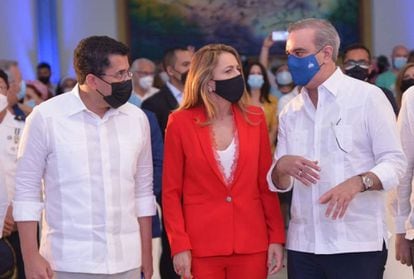Dominican Republic: a tourism success story
The Caribbean nation, which has vaccinated all hotel workers, is now receiving more bookings than it was before the pandemic in 2019

/cloudfront-eu-central-1.images.arcpublishing.com/prisa/TCCPBYRXQNB27GOKTJNNILILYU.jpg)
It is easy to forget about the coronavirus on the sandy beaches of the Dominican Republic. Peter, a German tourist who has turned a deep shade of pink over his two-week holiday, is fully vaccinated and only sorry today is the last of his trip. “This is paradise. It feels like there is no pandemic here,” he said. For the health-conscious who nonetheless want to travel, the pull of a vacation largely spent outdoors on a beach is strong, especially when everyone you are likely to meet has already been inoculated.
The Dominican Republic is leading the recovery of tourism in the Caribbean, driven by strong demand from US travelers. Almost 60% of Americans are fully vaccinated, and one of the effects is a stampede to go abroad and make up for lost time. By the end of May, the Dominican Republic saw a 10% increase in travelers booking to arrive in July than for the same dates in 2019, before the pandemic upended all travel.
There is pent-up demand that is now emerging. We expect the same to happen in other tourist destinations such as SpainAlejandro Reynal, CEO of Apple Leisure Group
The Caribbean nation is a beacon of hope for places like Spain and Greece in Europe, which rely strongly on tourism but are still waiting for vaccination campaigns on the continent to yield results for the sector. The concern now is whether this will happen in time to save the summer 2021 season, following the disaster of 2020, though at this point many businesses are clinging on for survival.
At 9am in Las Terrenas, in the northeast of the country, a dozen tourists are already sunbathing, while others enjoy breakfast on the Bahia Principe Grand El Portillo Hotel beachfront. The scene could be from 2019, but it is from 2021. Coronavirus safety measures are, however, in place. There are daily temperature checks at the hotel, face masks must be worn in busy areas and there is hydroalcoholic gel in abundance. The Dominican Republic no longer requires visitors to present a negative PCR test, though many visitors require them to get back home, and random tests are carried out in the main international airports.
What’s more, most of the people tourists are likely to come into contact with have been immunized. “All hotel workers have been vaccinated to guarantee the safety of the [tourism] sector. If tourism takes a step forward, we all do, because many families survive from the industry,” the president of the Dominican Republic, Luis Abinar, told media on a trip organized by Spanish tourism consortium Grupo Piñero. Abinader also emphasized that the recovery is already underway: “By the end of 2021 we will have similar numbers [in arrivals and spending] as before the Covid crisis,” he said.
The country’s tourism minister, David Collado, explained that the direct and indirect proceeds of tourism account for 22% of the nation’s gross domestic product (GDP). “For us, tourism is not a luxury, it spearheads our economy. It is good news that for July reservations are already at record levels, especially from the United States market,” he said. “International reservations for the Punta Cana-Bavaro area are already 37% higher than last year’s figures,” added Samuel Pereyra, general manager of state bank Banreservas.
Hotels fully booked
Hotel companies share in the sense of optimism and believe the strong numbers will be sustained into the second half of the year. “There are already fully booked hotels and they are asking us to raise the maximum occupancy allowed, which is now at 80%,” Collado said. Occupancy was lower overall in the first six months of 2021, but this is expected to change. The Bahia Principe hotel chain had 25% more tourists from the United States in the year up to June than in the same period of 2019. “With what has been booked so far, we are already up 50%,” said Encarna Piñero, CEO of Grupo Piñero. Punta Cana is at the maximum occupancy levels allowed by the pandemic.
Meanwhile, Sophia, from Orlando, Florida, is enjoying herself. “I am already vaccinated and I had a few weeks off, so I came without thinking twice. And by the end of the year I want to come back,” she said, speaking from a Grupo Piñero resort in Punta Cana.

American chain Apple Leisure Group (ALG) is in a similar situation. Throughout the Caribbean, the firm recorded a 40.45% increase in bookings between March 14 and May 23 when compared with the same dates in 2019. Alejandro Reynal, ALG’s managing director, expects this to be repeated worldwide: “There is pent-up demand that is now emerging. We expect the same to happen in other tourist destinations such as Spain.”
The Dominican Republic’s main tourism markets are the United States (more than two million tourists in 2019), Canada (almost 900,000), France and Russia (more than 200,000), as well as Argentina, Germany and Spain (close to 200,000), according to the Dominican Republic’s central bank. Among the thousands of tourists who plan to visit this year is Mercedes Romera, from Dos Hermanas in Spain’s Seville region. “I’m going with my parents, my husband and my two children. We are already vaccinated, except for the children, and we wanted a quiet place like Samaná, where there are hardly any infections and the workers are vaccinated.”
In spite of the optimism, the Dominican government remains cautious about the next setbacks the coronavirus pandemic might throw up. Overall this year will still be down on 2019′s takings, and full normality is not expected until 2022.
Investment plan
The Dominican government has also announced a raft of measures to improve tourism, including beach facilities ($10 million, €8.46 million), measures to combat algae ($12 million, €10.15 million with the private sector), beach regeneration ($70 million, €59.19 million with the Inter-American Investment Bank) and revamping cultural sites ($90 million, €76 million). Further measures include eliminating taxes on domestic flights in order to promote domestic tourism, which went from accounting for 3% to 35% of the sector last year – a rise largely explained by the 68% drop in international tourism. A new route between Madrid and Samaná will also open in July, operated by Air Europa.
/cloudfront-eu-central-1.images.arcpublishing.com/prisa/DEDWARNCG5BBF26NZ6XA3TTWLU.jpg)











































